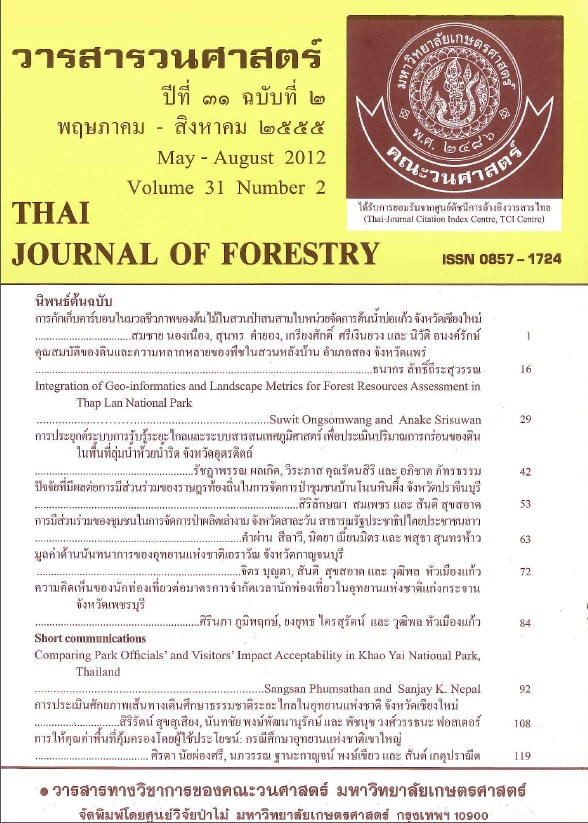การกักเก็บคาร์บอนในมวลชีวภาพสนสามใบและพรรณไม้ที่ขึ้นทดแทนในสวนป่าสนสามใบ หน่วยจัดการต้นน้ำบ่อแก้ว จังหวัดเชียงใหม่
Main Article Content
บทคัดย่อ
การกักเก็บคาร์บอนของสนสามใบและพรรณไม้ที่ขึ้นทดแทนในสวนป่าสนสามใบของหน่วยจัดการต้นน้ำบ่อแก้ว จังหวัดเชียงใหม่ อายุ 14-34 ปี โดยวางแปลงสุ่มตัวอย่างขนาด 40 x 40 ตารางเมตร ชั้นอายุละ 3 แปลง รวมทั้งหมด 63 แปลง วัดขนาดเส้นผ่าศูนย์กลางลำต้นที่ระดับ 1.3 ม. จากพื้นดิน และความสูงของต้นไม้ทุกต้นในแปลง เพื่อหามวลชีวภาพของไม้สนสามใบโดยสุ่มตัดตัวแทนต้นสนสามใบในสวนป่าที่กระจายตามชั้นอายุๆ ละ 1 ต้น ผลการวิจัยพบว่า มวลชีวภาพในสวนป่าผันแปรระหว่าง 11,281-39,707 กิโลกรัม/ไร่ เป็นมวลชีวภาพสนสามใบ 3,777-34,032 กิโลกรัม/ไร่ และพรรณไม้ชนิดอื่นๆ 1,479-15,057 กิโลกรัม/ไร่ การสะสมคาร์บอนในมวลชีวภาพของสวนป่าผันแปรระหว่าง 5,599-19,820 กิโลกรัม/ไร่ โดยมีการสะสมคาร์บอนในมวลชีวภาพสนสามใบ 1,896-17,036 กิโลกรัม/ไร่ และในพันธุ์ไม้ชนิดอื่นๆ 636-6,305 กิโลกรัม/ไร่ มวลชีวภาพและการสะสมคาร์บอนในมวลชีวภาพของสนสามใบมีแนวโน้มเพิ่มตามอายุของสวนป่า แต่มีความผันแปรสูงระหว่างชั้นอายุ ซึ่งเกิดจากปัจจัยหลายอย่าง พรรณไม้ที่ขึ้นทดแทนในสวนป่ามีบทบาทมากต่อการสะสมคาร์บอนในมวลชีวภาพ โดยมีค่าผันแปรระหว่างร้อยละ 4.11-71.36 ส่วนใหญ่เป็นไม้วงศ์ก่อ วงศ์เมี่ยง วงศ์ชมพู่ วงศ์ถั่ว วงศ์มะขามป้อม วงศ์เข็มและวงศ์อบเชย เป็นต้น
คำสำคัญ: สวนป่าสนสามใบ การทดแทนของพรรณไม้ มวลชีวภาพป่าไม้ การสะสมคาร์บอน
Downloads
Article Details

อนุญาตภายใต้เงื่อนไข Creative Commons Attribution-NonCommercial-NoDerivatives 4.0 International License.
ข้าพเจ้าและผู้เขียนร่วม (ถ้ามี) ขอรับรองว่า ต้นฉบับที่เสนอมานี้ยังไม่เคยได้รับการตีพิมพ์และไม่ได้อยู่ในระหว่างกระบวนการพิจารณาตีพิมพ์ลงในวารสารหรือสิ่งตีพิมพ์อื่นใด ข้าพเจ้าและผู้เขียนร่วม (ถ้ามี) ยอมรับหลักเกณฑ์และเงื่อนไขการพิจารณาต้นฉบับ ทั้งยินยอมให้กองบรรณาธิการมีสิทธิ์พิจารณาและตรวจแก้ต้นฉบับได้ตามที่เห็นสมควร พร้อมนี้ขอมอบลิขสิทธิ์ผลงานที่ได้รับการตีพิมพ์ให้แก่วารสารวนศาสตร์ คณะวนศาสตร์ มหาวิทยาลัยเกษตรศาสตร์ กรณีมีการฟ้องร้องเรื่องการละเมิดลิขสิทธิ์เกี่ยวกับภาพ กราฟ ข้อความส่วนใดส่วนหนึ่ง หรือ ข้อคิดเห็นที่ปรากฏในผลงาน ให้เป็นความรับผิดชอบของข้าพเจ้าและผู้เขียนร่วม (ถ้ามี) แต่เพียงฝ่ายเดียว และหากข้าพเจ้าและผู้เขียนร่วม (ถ้ามี) ประสงค์ถอนบทความในระหว่างกระบวนการพิจารณาของทางวารสาร ข้าพเจ้าและผู้เขียนร่วม (ถ้ามี) ยินดีรับผิดชอบค่าใช้จ่ายทั้งหมดที่เกิดขึ้นในกระบวนการพิจารณาบทความนั้น”


